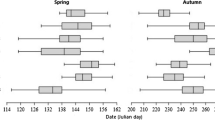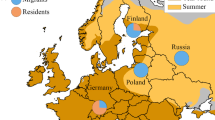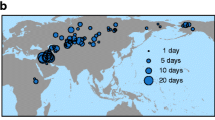Abstract
Migration distance is supposed to represent an important selection pressure shaping physiological and morphological properties. Previous work has focussed on this effect, while the importance of ecological barriers in this context has been rarely considered. We studied two subspecies of a migratory songbird, the northern wheatear (Oenanthe oenanthe oenanthe and O. o. leucorhoa L.), on an island in the North Sea. The former subspecies reaches their Scandinavian breeding areas after a short sea crossing, whereas leucorhoa northern wheatears cross the North Atlantic towards Iceland, Greenland or Canada. Physiological traits (fuel deposition rate) and wings’ aerodynamic properties (wing pointedness independent of body size), both affecting migration speed, were hypothesized to be more pronounced in leucorhoa than in oenanthe northern wheatears. Within subspecies, the physiological and aerodynamic properties were hypothesized to explain arrival date at the stopover site with “fast migrants” arriving early. Physiological and aerodynamic properties in leucorhoa northern wheatears lead to a faster and less costly migration, favouring a sea crossing, but in trade-off lower flight manoeuvrability than in oenanthe birds. Wings’ aerodynamic properties affected the seasonal occurrence of leucorhoa females, whereas the physiological traits significantly influenced arrival date in oenanthe individuals. The less risky migration route in oenanthe birds with few short sea crossings may have favoured higher flight manoeuvrability for foraging (less pointed wings), in trade-off an energetically more costly flight. Hence, not the migration distance itself, but the presence/absence of a sea barrier presents an important selection pressure in migratory land birds favouring low flight costs.





Similar content being viewed by others
References
Alerstam T, Lindström K (1990) Optimal bird migration: the relative importance of time, energy, and safety. In: Gwinner E (ed) Bird migration: physiology and ecophysiology. Springer, Berlin, pp 331–351
Alterstam T (2001) Detours in bird migration. J Theor Biol 209:319–331
Arlt D, Pärt T (2008) Post-breeding information gathering and breeding territory shifts in northern wheatears. J Anim Ecol 77:211–219
Arlt D, Forslund P, Jeppsson T, Pärt T (2008) Habitat-specific population growth of a farmland bird. PLoS ONE 3:e3006
Bächler E, Hahn S, Schaub M, Arlettaz R, Jenni L, Fox JW, Afanasyev V, Liechti F (2010) Year-round tracking of small trans-Saharan migrants using light-level geolocators. PLoS ONE 3:e9566
Bairlein F (1985) Efficiency of food utilization during fat deposition in the long-distance migratory garden warbler Sylvia borin. Oecologia 68:118–125
Bairlein F (1986) Spontaneous, approximately semimonthly rhythmic variations of body weight in the migratory garden warbler (Sylvia borin, Boddaert). J Comp Physiol B 156:859–865
Bairlein F (1987) Nutritional requirements for maintenance of body weight and fat deposition in the long-distance migratory garden warbler, Sylvia borin (Boddaert). Comp Biochem Physiol 86:A:337–A:347
Bairlein F, Norris DR, Nagel R, Bulte M, Voigt CC, Fox JW et al (2012) Cross-hemisphere migration of a 25-gram songbird. Biol Lett 8:505–507
Baldwin MW, Winkler H, Organ CL, Helm B (2010) Wing pointedness associated with migratory distance in common-garden and comparative studies of stonechats (Saxicola torquata). J Evol Biol 23:1050–1063
Bearhop S, Fiedler W, Furness RW, Votier SC, Waldron S, Newton J et al (2005) Assortative mating as a mechanism for rapid evolution of a migratory divide. Science 310:502–504
Berthold P, Querner U (1981) Genetic basis of migratory behavior in European warblers. Science 212:77–79
Berthold P, Querner U (1988) Was Zugunruhe wirklich ist - eine quantitative Bestimmung mit Hilfe von Video-Aufnahmen bei Infrarotbeleuchtung. J Ornithol 129:372–375
Bowen GJ (2008) Spatial analysis of the intra-annual variation of precipitation isotope ratios and its climatological corollaries. J Geophys Res 113:D05113
Bowen GJ (2010) Isoscapes: spatial pattern in isotopic biogeochemistry. Annu Rev Earth Pl Sc 38:161–187
Bowen GJ, Revenaugh J (2003) Interpolating the isotopic composition of modern meteoric precipitation. Water Resour Res 39:1299
Bowlin MS, Wikelski M (2008) Pointed wings, low wingloading and calm air reduce migratory flight costs in songbirds. PLoS ONE 3:e2154
Brook MDL (1979) Differences in the quality of territories held by wheatears (Oenanthe oenanthe). J Anim Ecol 48:21–32
Buchmann M (2001) Die Brutbiologie des Steinschmatzers (Oenanthe oenanthe) auf intensiv genutzten Flächen in Rheinland-Pfalz. Vogelwarte 41:1–17
Bulte M, Bairlein F (2013) Endogenous control of migratory behavior in Alaskan northern wheatears Oenanthe oenanthe. J Ornithol 154:567–570
Conder PJ (1956) The territory of the wheatear Oenanthe oenanthe. Ibis 98:453–459
Conklin J, Battley PF, Potter MA, Fox JW (2010) Breeding latitude drives individual schedules in a trans-hemispheric migrant bird. Nat Commun 1:67
Currie D, Thompson DBA, Burke T (2000) Patterns of territory settlement and consequences for breeding success in the wheatear Oenanthe oenanthe. Ibis 142:389–398
Delingat J, Dierschke V, Schmaljohann H, Mendel B, Bairlein F (2006) Daily stopovers as optimal migration strategy in a long-distance migrating passerine: the northern wheatear. Ardea 94:593–605
Delingat J, Hobson K, Dierschke V, Schmaljohann H, Bairlein F (2011) Population differentiation of northern wheatears by means of morphometric data and stable isotopes. J Ornithol 152:383–395
Dierschke V, Delingat J (2001) Stopover behaviour and departure decision of northern wheatears, Oenanthe oenanthe, facing different onward non-stop flight distances. Behav Ecol Sociobiol 50:535–545
Dierschke V, Mendel B, Schmaljohann H (2005) Differential timing of spring migration in northern wheatears Oenanthe oenanthe: hurried males or weak females? Behav Ecol Sociobiol 57:470–480
Dierschke J, Dierschke V, Hüppop K, Hüppop O, Jachmann KF (2011) Die Vogelwelt der Insel Helgoland. OAG Helgoland, Helgoland
Dinno A (2009) Exploring the sensitivity of Horn’s parallel analysis to the distributional form of random data. Multivariate Behav Res 44:362–388
Erni B, Liechti F, Bruderer B (2002) Stopover strategies in passerine bird migration: a simulation study. J Theor Biol 219:479–493
Fiedler W (2005) Ecomorphology of the external flight apparatus of blackcaps (Sylvia atricapilla) with different migration behaviour. Ann NY Acad Sci 1046:253–263
Fitzpatrick S (1998) Intraspecific variation in wing length and male plumage coloration with migratory behaviour in continental and Island populations. J Avian Biol 29:248
Förschler MI, Bairlein F (2011) Morphological shifts of the external flight apparatus across the range of a passerine (northern wheatear) with diverging migratory behaviour. PLoS ONE 6:e18732
Fransson T, Jakobsson S, Johansson P, Kullberg C, Lind J, Vallin A (2001) Magnetic cues trigger extensive refuelling. Nature 414:35–36
Gerson AR, Guglielmo CG (2013) Energetics and metabolite profiles during early flight in American robins (Turdus migratorius). J Comp Physiol B 183:983–991
Gill RE, Tibbitts TL, Douglas DC, Handel CM, Mulcahy DM, Gottschalck JC et al (2009) Extreme endurance flights by landbirds crossing the Pacific Ocean: ecological corridor rather than barrier? Proc R Soc Lond B 276:447–457
Glorfeld LW (1995) An improvement on Horn’s parallel analysis methodology for selecting the correct number of factors to retain. Educ Psychol Meas 55:377–393
Gunnarsson TG, Gill JA, Atkinson PW, GéLinaud G, Potts PM, Croger RE, Gudmundsson GA, Appleton GF, Sutherland WJ (2006) Population-scale drivers of individual arrival times in migratory birds. J Anim Ecol 75:1119–1127
Gwinner E (1996) Circadian and circannual programmes in avian migration. J Exp Biol 199:39–48
Hedenström A, Pettersson J (1987) Migration routes and wintering areas of willow warblers Phylloscopus trochilus (L.) ringed in Fennoscandia. Ornis Fennica 64:137–143
Henningsson SS, Alerstam T (2005) Barrier and distances as determinants for the evolution of bird migration links: the arctic shorebird system. Proc R Soc Lond B 272:2251–2258
Horn JL (1965) A rationale and a test for the number of factors in factor analysis. Psychometrika 30:179–185
Houston AI (1998) Models of optimal avian migration: state, time and predation. J Avian Biol 29:395–404
Jenni L, Jenni-Eiermann S (1998) Fuel supply and metaboli constraints in migrating birds. J Avian Biol 29:521–528
Jenni L, Winkler R (1994) Moult and ageing of European passerines. Academic Press, London
Klaassen M, Biebach H (1994) Energetics of fattening and starvation in the long-distance migratory garden warbler, Sylvia borin, during the migratory phase. J Comp Physiol B 164:362–371
Kokko H (1999) Competition for early arrival in birds. J Anim Ecol 68:940–950
Kokko H, Gunnarsson TG, Morrell LJ, Gill JA (2006) Why do female migratory birds arrive later than males? J Anim Ecol 75:1293–1303
Langin KM, Marra PP, Nemeth Z, Moore FR, Kyser KT, Ratcliffe LM (2009) Breeding latitude and timing of spring migration in songbirds crossing the Gulf of Mexico. J Avian Biol 40:309–316
Lank DB, Butler RW, Ireland J, Ydenberg RC (2003) Effects of predation danger on migration strategies of sandpipers. Oikos 103:303–319
Leisler B, Winkler H (2003) Morphological consequences of migration in passerines. In: Berthold PG (ed) Avian Migration. Springer, Berlin, pp 175–186
Liechti F (2006) Birds: blowin’ by the wind? J Ornithol 147:202–211
Lindström A, Alerstam T (1992) Optimal fat loads in migrating birds: a test of the time-minimization hypothesis. Am Nat 140:477–491
Lockwood R, Swaddle JP, Rayner JMV (1998) Avian wingtip shape reconsidered: wingtip shape indices and morphological adaptations to migration. J Avian Biol 29:273–292
Maggini I (2009) Migratory strategies in the northern wheatear (Oenanthe oenanthe). Institute of Avian Research “Vogelwarte Helgoland”
Maggini I, Bairlein F (2010) Endogenous rhythms of seasonal migratory body mass changes and nocturnal restlessness in different populations of northern wheatear Oenanthe oenanthe. J Biol Rhythm 25:268–276
Maggini I, Bairlein F (2012) Innate sex differences in the timing of spring migration in a songbird. PLoS ONE 7:e31271
Maggini I, Bairlein F (2013) Metabolic response to changes in temperature in northern wheatears from an arctic and a temperate populations. J Avian Biol. doi:10.1007/s10336–012–0896–1
Maggini I, Spina F, Voigt CC, Ferri A, Bairlein F (2013) Differential migration and body condition in northern wheatears (Oenanthe oenanthe) at a Mediterranean spring stopover site. J Ornithol 154:321–328
Marchetti K, Price T, Richman A (1995) Correlates of wing morphology with foraging behaviour and migration in the genus Phylloscopus. J Avian Biol 26:177–181
Marra PP, Hobson KA, Holmes RT (1998) Linking winter and summer events in a migratory bird by using stable-carbon isotopes. Science 282:1884–1886
Mönkkönen M (1995) Do migrant birds have more pointed wings? A comparative study. Evol Ecol 9:520–528
Morbey YE, Ydenberg RC (2001) Protandrous arrival timing to breeding areas: a review. Ecol Lett 4:663–673
Newton I (2007) Weather-related mass-mortality events in migrants. Ibis 149:453–467
Norberg UM (1990) Vertebrate flight: mechanics, physiology, morphology, ecology and evolution. Springer, Heidelberg
Pennycuick CJ (1999) Measuring bird’ wings for flight performance calculations. Boundary Layer, Bristol
Pennycuick CJ (2008) Modelling the flying bird. Elsevier, Amsterdam
R Development Core Team (2012) R: a language and environment for statistical computing. R Foundation for Statistical Computing, Vienna, Austria. URL http://www.r-project.org/
Rayner JMV (1988) Form and function in avian flight. In: Johnston RF (ed) Current ornithology. Plenum, New York, pp 1–66
Rychlik L, Jancewicz E (2002) Prey size, prey nutrition, and food handling by shrews of different body sizes. Behav Ecol 13:216–223
Saino N, Szép T, Romano M, Rubolini D, Spina F, Møller AP (2004) Ecological conditions during winter predict arrival date at the breeding quarters in a trans-Saharan migratory bird. Ecol Lett 7:21–25
Schaub M, Liechti F, Jenni L (2004) Departure of migrating European robins, Erithacus rubecula, from a stopover site in relation to wind and rain. Anim Behav 67:229–237
Schmaljohann H, Naef‐Daenzer B (2011) Body condition and wind support initiate the shift of migratory direction and timing of nocturnal departure in a songbird. J Anim Ecol 80:1115–1122
Schmaljohann H, Becker PJJ, Karaardic H, Liechti F, Naef-Daenzer B, Grande C (2011) Nocturnal exploratory flights, departure time, and direction in a migratory songbird. J Ornithol 152:439–452
Schmaljohann H, Buchmann M, Fox JW, Bairlein F (2012a) Tracking migration routes and the annual cycle of a trans-Sahara songbird migrant. Behav Ecol Sociobiol 66:915–922
Schmaljohann H, Fox JW, Bairlein F (2012b) Phenotypic response to environmental cues, orientation and migration costs in songbirds flying halfway around the world. Anim Behav 84:623–640
Schmaljohann H, Korner-Nievergelt F, Naef-Daenzer B, Nagel R, Maggini I, Bulte M et al (2013) Stopover optimization in a long-distance migrant: the role of fuel load, temperature and nocturnal take-off time in Alaskan northern wheatears (Oenanthe oenanthe). Front Zool 10:26
Shamoun-Baranes J, Leyrer J, van Loon E, Bocher P, Robin F, Meunier F et al (2010) Stochastic atmospheric assistance and the use of emergency staging sites by migrants. Proc R Soc Lond B 277:1505–1511
Singh J, Budki P, Rani S, Kumar V (2011) Temperature alters the photoperiodically controlled phenologies linked with migration and reproduction in a night-migratory songbird. Proc R Soc Lond B 279:509–515
Spina F, Massi A, Montemaggiori A (1994) Back from Africa: who’s running ahead? Aspects of differential migration of sex and age classes in Palearctic-African spring migrants. Ostrich 65:137–150
Svensson L (1992) Identification guide to European passerines. BTO, Stockholm
Swaddle JP, Lockwood R (2003) Wingtip shape and flight performance in the European starling Sturnus vulgaris. Ibis 145:457–464
Totzke U, Hübinger A, Bairlein F (1998) Glucose utilization rate and pancreatic hormone response to oral glucose loads are influenced by the migratory condition and fasting in the garden warbler (Sylvia borin). J Endocrinol 158:191–196
Whittow GC (2000) Avian physiology. Academic, San Diego
Acknowledgments
Continuous field work over the years was only possible because of the enormous support from P.J.J. Becker, T. Bleifuß, M. Berg, J. Delingat, J. Dierschke, V. Dierschke, S. Engel, A. Fischer, C. Grande, B. Holtmann, S. Jaquier, K.F. Jachmann, H. Karaardic, B. Mendel, K. Müller, W. Plötner, I. Prugger, M. Rebke, J. Röw, S. Stadtmann, C. Struckmeyer and A. Walter. Technical support for the experiment was obtained from O. Hüppop, K. Müller and F. Schramm. HS is financed by the German Research Foundation (SCHM 2647/1-1). The authors have no conflict of interest to declare. We thank two anonymous reviewers for helpful comments on the manuscript.
Ethical Standards
Wheatears were caught, ringed and kept in captivity under licence of the Ministry for Agriculture, the Environment and Rural Areas, Schleswig-Holstein, Germany. All animals were handled in strict accordance with good animal practice and all efforts were made to minimize suffering.
Author information
Authors and Affiliations
Corresponding author
Additional information
Communicated by W. Wiltschko
Electronic supplementary material
Below is the link to the electronic supplementary material.
Appendix S1
Estimation of wing area (DOCX 103 kb)
Rights and permissions
About this article
Cite this article
Corman, AM., Bairlein, F. & Schmaljohann, H. The nature of the migration route shapes physiological traits and aerodynamic properties in a migratory songbird. Behav Ecol Sociobiol 68, 391–402 (2014). https://doi.org/10.1007/s00265-013-1653-z
Received:
Revised:
Accepted:
Published:
Issue Date:
DOI: https://doi.org/10.1007/s00265-013-1653-z




